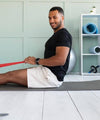Recent Post
Archive
- November 2021

Repeated efforts to heal empower love yourself.
E&E-2 Admin
Nov 16, 2021
According to the Mayo Clinic, a panic attack is “a sudden episode of intense fear that triggers severe physical reactions when there is no real danger or apparent cause.” Those of us who experience such bouts, frequently or on occasion, are likely familiar with the accompanying fluttering heart, uneasy breathing, racing thoughts, and tightness in the jaw, throat, or other areas of the body. These attacks are also often accompanied by imagining the worst possible outcomes or feelings of low self-worth, and all we want is for the brain games and other unpleasantness to stop.
Just as with trauma (which may or may not underlie panic attacks), the key is to find what psychiatrist and The Body Keeps the Score author Dr. Bessel van der Kolk calls “a sense of safety in the body.” That’s the intention of the easy practice that follows, which helps to integrate the emotional and rational hemispheres of the brain and allows the mind and body to reconnect. And while the practice is loved by my yoga therapy clients who have found it to be very effective when they find themselves spiraling into an attack, a method that is helpful for one individual may not prove effective for others.
The Practice
Crossing the midline in the body in order to unite and engage both hemispheres of the brain is a method that’s used in a variety of occupational therapy techniques for both physical and mental concerns in children and adults. Its purpose is to create a connection between our limbic brain, the more primitive fight-flight-freeze response in the right hemisphere, with our more logical, rational left-hemisphere functions in order to reduce our anxiety and make ourselves feel safer. The other components—self touch and long exhalations—are also shown to lower stress levels.
To get started, you can sit in a chair or lie down. Cross your wrists and stroke the outsides of your legs as far down as you can reach and then up the insides three or four times, allowing your exhalations to be longer than your inhalations, but without worrying about connecting breath with movement. Then reverse direction for three or four cycles—stroking down the insides of your legs and up the outsides. For a double dose, switch the wrist you had on top and repeat. Then pause and notice if you feel less “up in your head” and a little more grounded, rooted, and steady in your body.
Some of my clients use this technique while parked in a car or on a break between meetings to de-stress and put the kibosh on panic. If stroking your legs doesn’t feel good to you, you can try tapping down and up, up and down. The key is remembering the long exhalations to nip panic in the bud!
← Older Post Newer Post →




